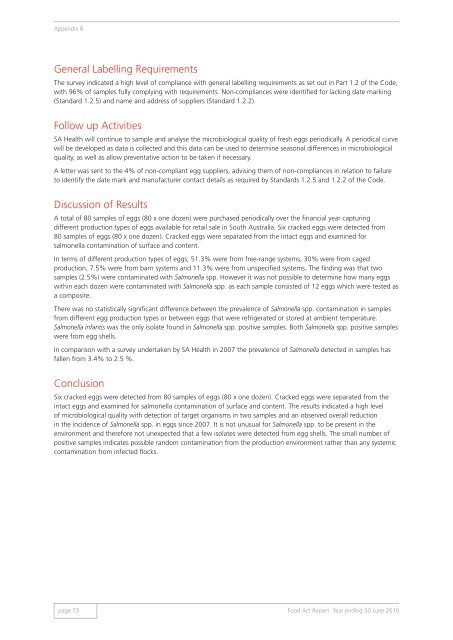Food Act Report 2009/2010 - SA Health - SA.Gov.au
Food Act Report 2009/2010 - SA Health - SA.Gov.au
Food Act Report 2009/2010 - SA Health - SA.Gov.au
Create successful ePaper yourself
Turn your PDF publications into a flip-book with our unique Google optimized e-Paper software.
Appendix 8General Labelling RequirementsThe survey indicated a high level of compliance with general labelling requirements as set out in Part 1.2 of the Code,with 96% of samples fully complying with requirements. Non-compliances were identified for lacking date marking(Standard 1.2.5) and name and address of suppliers (Standard 1.2.2).Follow up <strong>Act</strong>ivities<strong>SA</strong> <strong>Health</strong> will continue to sample and analyse the microbiological quality of fresh eggs periodically. A periodical curvewill be developed as data is collected and this data can be used to determine seasonal differences in microbiologicalquality, as well as allow preventative action to be taken if necessary.A letter was sent to the 4% of non-compliant egg suppliers, advising them of non-compliances in relation to failureto identify the date mark and manufacturer contact details as required by Standards 1.2.5 and 1.2.2 of the Code.Discussion of ResultsA total of 80 samples of eggs (80 x one dozen) were purchased periodically over the financial year capturingdifferent production types of eggs available for retail sale in South Australia. Six cracked eggs were detected from80 samples of eggs (80 x one dozen). Cracked eggs were separated from the intact eggs and examined forsalmonella contamination of surface and content.In terms of different production types of eggs, 51.3% were from free-range systems, 30% were from cagedproduction, 7.5% were from barn systems and 11.3% were from unspecified systems. The finding was that twosamples (2.5%) were contaminated with Salmonella spp. However it was not possible to determine how many eggswithin each dozen were contaminated with Salmonella spp. as each sample consisted of 12 eggs which were tested asa composite.There was no statistically significant difference between the prevalence of Salmonella spp. contamination in samplesfrom different egg production types or between eggs that were refrigerated or stored at ambient temperature.Salmonella infantis was the only isolate found in Salmonella spp. positive samples. Both Salmonella spp. positive sampleswere from egg shells.In comparison with a survey undertaken by <strong>SA</strong> <strong>Health</strong> in 2007 the prevalence of Salmonella detected in samples hasfallen from 3.4% to 2.5 %.ConclusionSix cracked eggs were detected from 80 samples of eggs (80 x one dozen). Cracked eggs were separated from theintact eggs and examined for salmonella contamination of surface and content. The results indicated a high levelof microbiological quality with detection of target organisms in two samples and an observed overall reductionin the incidence of Salmonella spp. in eggs since 2007. It is not unusual for Salmonella spp. to be present in theenvironment and therefore not unexpected that a few isolates were detected from egg shells. The small number ofpositive samples indicates possible random contamination from the production environment rather than any systemiccontamination from infected flocks.page 73<strong>Food</strong> <strong>Act</strong> <strong>Report</strong> Year ending 30 June <strong>2010</strong>
















